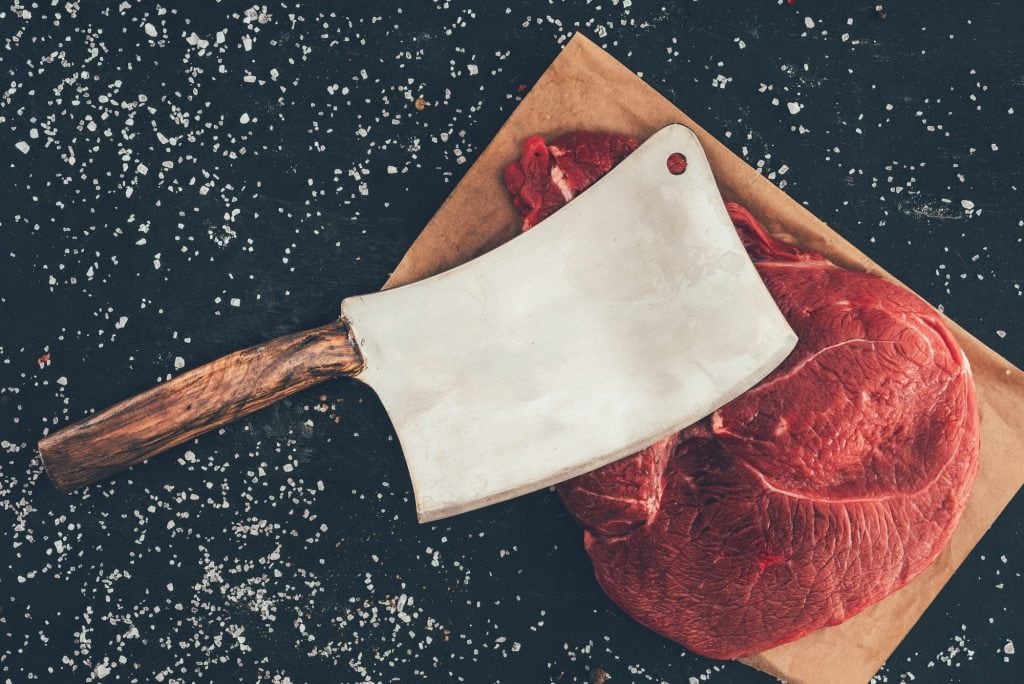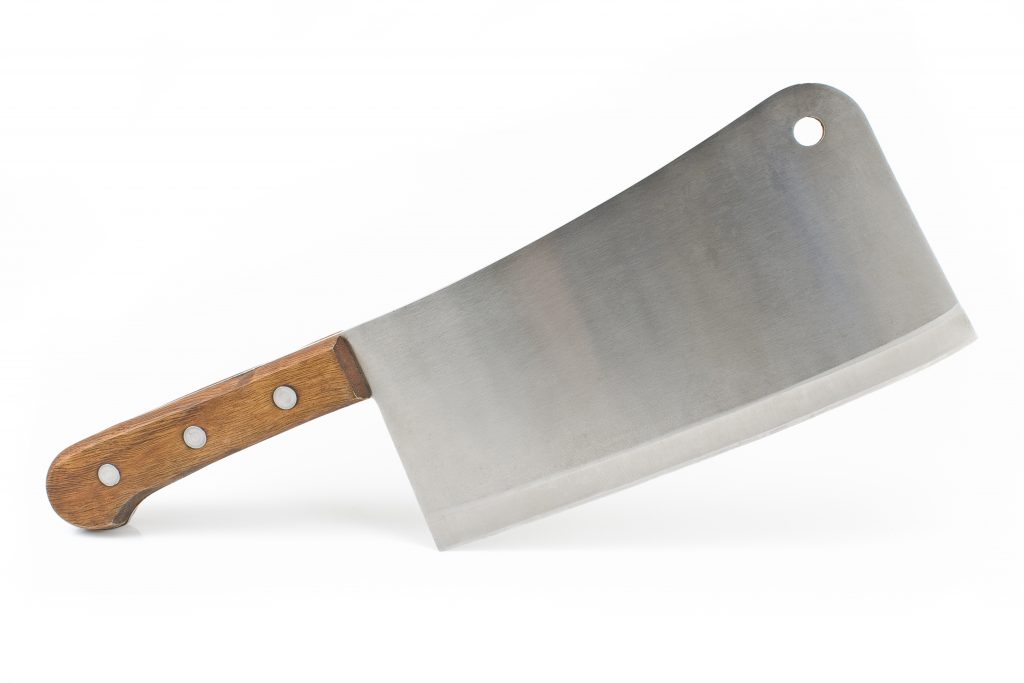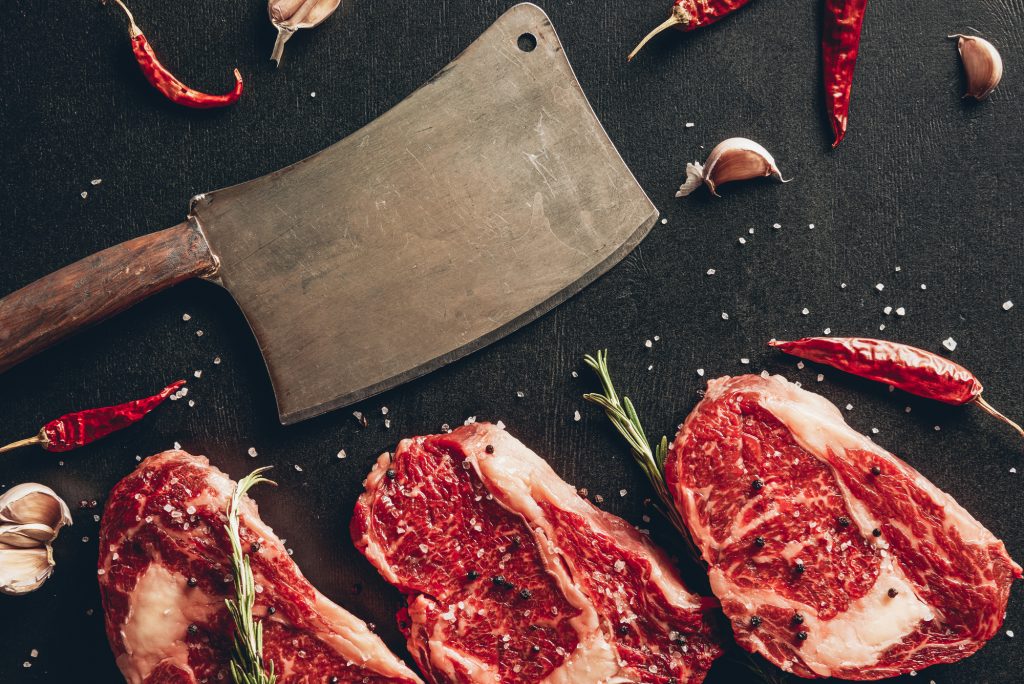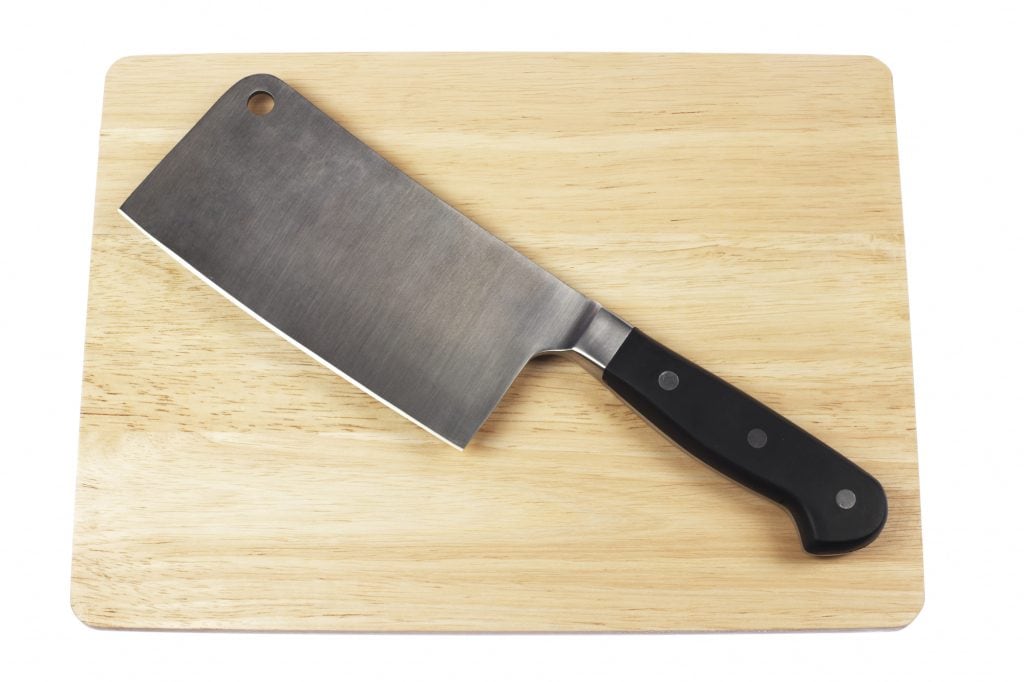No matter if you are running a food truck serving the hungry masses at a farmers market in Arizona or preparing a family dish in your New York apartment, having the right tools is critical. You want the marriage of quality ingredients prepped the way that makes your food sing on the taste buds of your guests. That is why we at Knives Academy have put together this comprehensive buying guide for discovering the perfect meat cleaver for your needs. Be sure to also check out our article on the 5 Best Meat Cleavers we think you should consider. In the meantime, read ahead for our buying guide.
Read now >> Types of Cleavers
How to Choose the Best Meat Cleaver For You?
A meat cleaver is different than the other blades in your kitchen area. This is not a precision instrument for getting clean, accurate slices of meat. This is a heavy-duty, large blade meant to take apart all sorts of ingredients.
You are going to get a rough cut, but that is what is needed in situations like:
- Splitting apart large pieces of soft bones with chicken or duck
- Slashing through thick pieces of cuts like certain sirloins, crab meat, and shanks
- Dividing up tough vegetables like oversized sweet potato, beets, or other thicker rooted ingredients
- Any other prep work that requires tearing apart larger ingredients like for stews, salads, specialty dishes, or working with larger pieces of uncut meats
While meat cleavers can undoubtedly take a punch, they are not intended for use with:
- Thin slicing of meats for presentation
- Cutting through solid, frozen, or hard bones
- Deboning fish or other delicate knife work
Finding the suitable meat cleaver for your kitchen depends a lot on your presence and how you will be using the blade. Many kitchens focused on French or Asian cuisine use meat cleavers as their blade of choice, while others use them only as a prep instrument.
Whatever your reason, we will go into the details of how to find the best meat cleaver for your situation and needs. We do our best to cover all the aspects of a quality meat cleaver and how to pick out the features that will enhance your kitchen capabilities.

Price – How Much Does A Meat Cleavers Cost?
The reality is meat cleaver pricing can vary wildly. You can find some hot TV commercial brands that will get the job done for as little as $15 or work your way up to a precision German or Japanese crafted, full tang beauty for upwards of $250. The actual determination is going to be how the blade is made, what its materials are, and the overall size and design. A good quality meat cleaver for personal use in the kitchen will probably run you anywhere from $49-$125.
Are meat cleavers worth it?
If you use many ingredients in your home or professional kitchen that require chopping through dense, heavy, and thicker pieces of meat and vegetables, then yes, the cost of a meat cleaver is worth it. Not to mention it looks pretty amazing when you have a sized meat cleaver hanging up next to your other blades on the wall. It’s kind of like a signal to all your guests they are in for a treat when you host a meal.
Dimensions – The Length & Weight of a Meat Cleavers
The primary purpose of a solid meat cleaver is to separate large ingredients. If you do not have the length and weight to get the momentum you need for the cutting, you might as well order take out.
The length of a meat cleaver
The total length of a meat cleaver is measured from the base of the handle to the end of the blade. In general, you want a handle that fits your whole fists without rubbing against the edge of the blade and a knife length around 6.5-7.5 inches (16.5-19.05cm). Too large, and it will feel clumsy, too little, and you will not be able to cut through the ingredients you want to use.
We should also point out a subtle feature that first-time meat cleavers may not understand. The height of the blade is essential for flushing or swiping ingredients into dishes. For Western or Asian-inspired cooking, you will want a cleaver with around 3” (7.62cm) in height.
What Is the best length for a meat cleaver?
For our money, we would stick with a medium-sized meat cleaver of roughly 6.75 inches in blade length and at least 3 inches in height. This will give you the most versatility in your home kitchen and allow you to handle the heaviest ingredients outside of an actual full-sized animal.
The weight of a meat cleaver
Like length, you are looking for a blade that is heavy enough to do most of the work of cutting through large ingredients, so your hands and wrists do not get tired with bigger meals or repetitive use. A 6-inch blade will weigh 10oz to a pound (283.5-453.6g), and that may feel a little light, while an 8-inch blade can be up to 2 pounds (907g), and that will feel like you are trying to handle a flagpole in your hand.
What is a good weight for a meat cleaver?
For the total weight of the meat cleaver, from hilt to blade, you should look for something between 15oz-1.3 pounds (425.2-553g). This will give you enough heft to help make those difficult cuts without placing too much pressure on your cutting arm.
The Meat Cleavers Blade

The blade of the meat cleaver is what makes it so unique. Between having a sturdy belly that can scoop up cut ingredients to a decent heel for rocking back on when cutting quickly, how your blade is crafted will make a significant difference in its price and value.
In general, the blade has a long spine that is the “top” or blunt end of the blade extended from the hilt. Below that is the belly, sometimes a hole, then the actual sharp edge with a point (farthest away) and a heel (closets to hand) on either end. Let’s go over some more details about the meat cleaver blade.
What is the difference between forged and stamped blades for a meat cleaver?
A forged meat cleaver will usually have a partial or full tang. That means the metal of the blade extends into the hilt. Forging a blade takes a lot more time and money than stamping and results in a final product that is meant to be of better quality and made from a single piece of steel.
Stamped blades are made by cutting large sheets of metal into patterns that are then fixed into the handle. They can be full tang but tend to partial or none. There are also combinations of partially forged and stamped cleavers on the market.
For most knives in your arsenal, a combination of forged and stamped is perfectly fine and, in many cases, the superior choice. The only reason to hesitate on this decision with a meat cleaver is that a lot of momentum and force is being applied to the blade to get good thick cuts. That is why we lean towards picking out a forged blade over stamped. It is going to have the durability you will need.
Blade Material – What material should a meat cleaver blade be made of?
The materials used to create your meat cleaver will matter to durability, weight, sharpness, and cleaning methods you use when finished prepping your food. Each of the common metals has its advantages and disadvantages.
- Carbon – this is a blend of carbon and iron that can rust quickly if not taken care of. It is more durable than other metals and easier to sharpen.
- Stainless steel – has a shinier and smoother appearance and is less prone to rust. However, it is made of softer metals and will not stay as sharp as you would like.
- Laminated or Damascus steel combines two or more alloys and usually has beautiful wavy lines. The main advantage is that this blade is pattern welded and is usually much harder than other blades.
- Ceramic – made from zirconium oxide, these blades are extremely hard and sharp with an almost deceptive lightness. The sharpness can last for years, but tend to be on the extreme pricy side.
- Titanium – offers much of the same sharpness as a medium steel but does not have any of the corrosion issues as other metals. You’ll actually find a lot of divers using titanium knives for safety in seawater.
Our choice would be a combination of a few methods. If you can find a decent ceramic with a heavy enough weight, then that is always a good choice. Otherwise, a high carbon stainless steel combination with full tang is a great option.
Blade Flexibility – Should a meat cleaver have a flexible blade?
Blade flexibility matters when you work around complex cuts or hard to manage bones. You usually do not want a lot of flexibility in a meat cleaver because you are cutting through heavier ingredients and want the blade to land precisely where you aim. This is a heavy-duty kitchen instrument and should be treated as such.
Blade Width/Thickness – How thick should a meat cleaver blade be?
Most Western-styled meat cleavers will range from 13 degrees to 25 degrees from the edge of the cutting point to the top of the spine. If you do a lot of Asian cooking, you may want a thinner blade to work around all the different ingredients, but in general, stick to 15-17 degrees for a well-balanced cooking blade. Thickness has a lot to do with overall weight, and you want something that feels right in your hand.
Tang
This is probably the second most crucial part of a meat cleaver next to the material steel you select. Many blades with only partial tang extend a little into the handle, but for our safety and money, getting a full tang meat cleaver is always the best choice. You are placing a lot of weight, pressure, and downward motion on this heavy-duty knife, and you do not want it to suddenly break on the board.
HRC
The Rockwell scale measures the hardness of a blade’s materials (steel, ceramic, etc.). For example, an HRC for an everyday kitchen knife is usually between 52-54 HRC, whereas a premium blade would be around 59-64 HRC.
Cleavers are heavy-duty instruments that take a lot of abuse in a professional kitchen. Therefore, you should look for something with an HRC rating of 54-58 to be on the safe side.
Edge profile – What edge should a meat cleaver have?
This part is the real nitty-gritty of meat cleaver design. Each edge type makes a difference with the primary cutting you will be doing in the kitchen. It also matters a great deal for how long the blade will remain sharp over time. Usually, the smaller the bevel, the sharper the blade. For the most part, you can expect to find edge profiles like:

Double Bevel
The angle of the degree is formed on both sides of the blade. This is the common V-shape you see in European-made blades and is designed for heavy cutting without much precision work.
Convex Edge
This is made with only one side of the edge being angled and is sometimes called a chiseled edge. This blade is exceptionally sharp. We cannot stress this enough. If you buy this kind of cleaver, you are most likely using it for sushi work, Asian cuisine, or a butcher’s shop.
Chisel Edge or Single Bevel
This type of edge is slightly rounded and tapers off to a fine point for the actual cutting sharpness. This gives you much longer durability and less drag while cutting and allows a much easier sharpening.
The Meat Cleaver’s Handle
The handle of a meat cleaver is equally essential because you do not want to lose your grip while cutting down. The vibration of a solid cut can impact your overall presentation and the quality of ingredients. You want a slightly angled bolster with a tapered butt that allows your whole hand to grip the handle if needed. If you have rivets, they should reflect the metal of the tang.
- Size – your whole hand should be able to fit the handle in a fist grip.
- Comfort & Grip – ergonomic designs with high-quality steel mixtures or premium plastics are good here because you want something that will be easy to clean while dampening the vibration and impact of a cut.
- Material – do not get wood. Metal, plastic, or a combination that allows you to maintain a grip are fine, but wood will get gross from all the meat used after a while.
- Design – we like handles with some curvature along where you would rest your fingers for added grip capabilities.
Balance
This is a complex attribute to strike. A good blade will have a more extended handle to place the balance just on the blade side of the bolster. You want a heavier blade than a handle, whereas other kitchen knives seek something in the middle. In the end, look for a blade with about 35-45% of the length being in the handle. Unless you do a lot of Asian cooking then a shorter handle is acceptable as there is a lot of rocking motion from the blade’s heel.
Maintenance and Care – How to Maintain a Meat Cleaver ?

Meat cleavers are frequently used with raw ingredients that can lead to bacteria or damage the blade’s metal over time. You need to keep your meat cleavers in tip-top shape if they are going to perform when you are cooking. That also means not leaving your blades in water to soak.
How to clean a meat cleaver?
Different materials will have specific cleaning methods that are almost always included in the instructions or manufacturer’s guide you receive when making a purchase. Using slightly hot water with a small amount of soap is okay as long as you dry off the blade entirely after washing. You do not want any water staying on the blade too long, so it can damage the blade’s integrity or sharpness.
Are meat cleavers Dish-washer Safe?
If you have a ceramic blade, you’ll probably be fine in a dishwasher, but we recommend against it for both material durability and safety to you and your family. The best thing to do is hand wash your meat cleaver and then dry it thoroughly.
Honing & sharpening your cleaver, How to keep your meat cleaver Sharp?
The rule of thumb is to sharpen your blade with sharpening steel because that prevents any material from being removed in the process. Sharpening steel used in the vertical position will reform the edge instead of removing metal.
Read now >> How to tell if a knife is sharp?
Depending on the material you used for your blade, you probably will only have to sharpen it every few months and even then sparingly. For most kitchens, about every 6 months will be fine.
How to store a meat cleaver?
The best way to store a meat cleaver is to hang it from its hole. This is the main reason why meat cleavers have a hole.
We cannot stress this enough – a meat cleaver is a seriously sharp, heavy-duty kitchen instrument. Do not store a meat cleaver anywhere a child can get their hands on it. Using a storage block or magnetic bar is fine as long as it is away from little ones.
You also want a nice dry space so no water can gather or remain on the blade after you have cleaned it by hand. Avoiding rust is a decent concern.
Conclusion
Meat cleavers are excellent blades to have on hand in your kitchen. They can cut down (no pun intended) on the time of your preparation work and are a lot of fun to perfect when cooking Asian cuisine. Of course, finding the perfect cleaver for your daily use will matter on your intentions and personal preference, but this buying guide offers a decent amount of insight into what attributes you should be looking for in your purchase.
No matter what, stay safe with your cleaver and have fun cooking up exquisite dishes for you and your guests with one of the most recognizable blades in the world.
